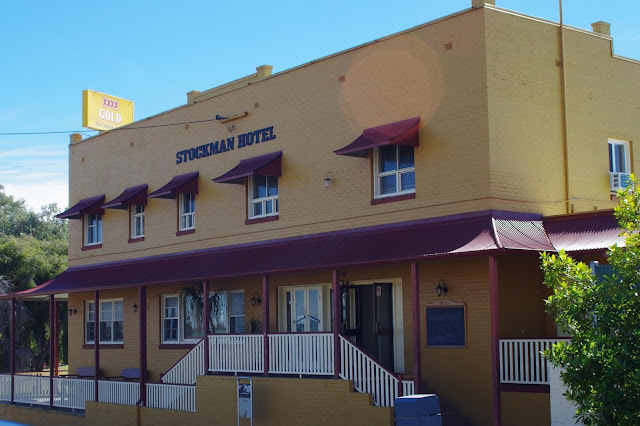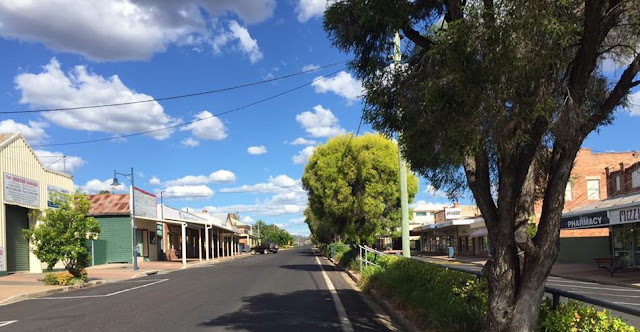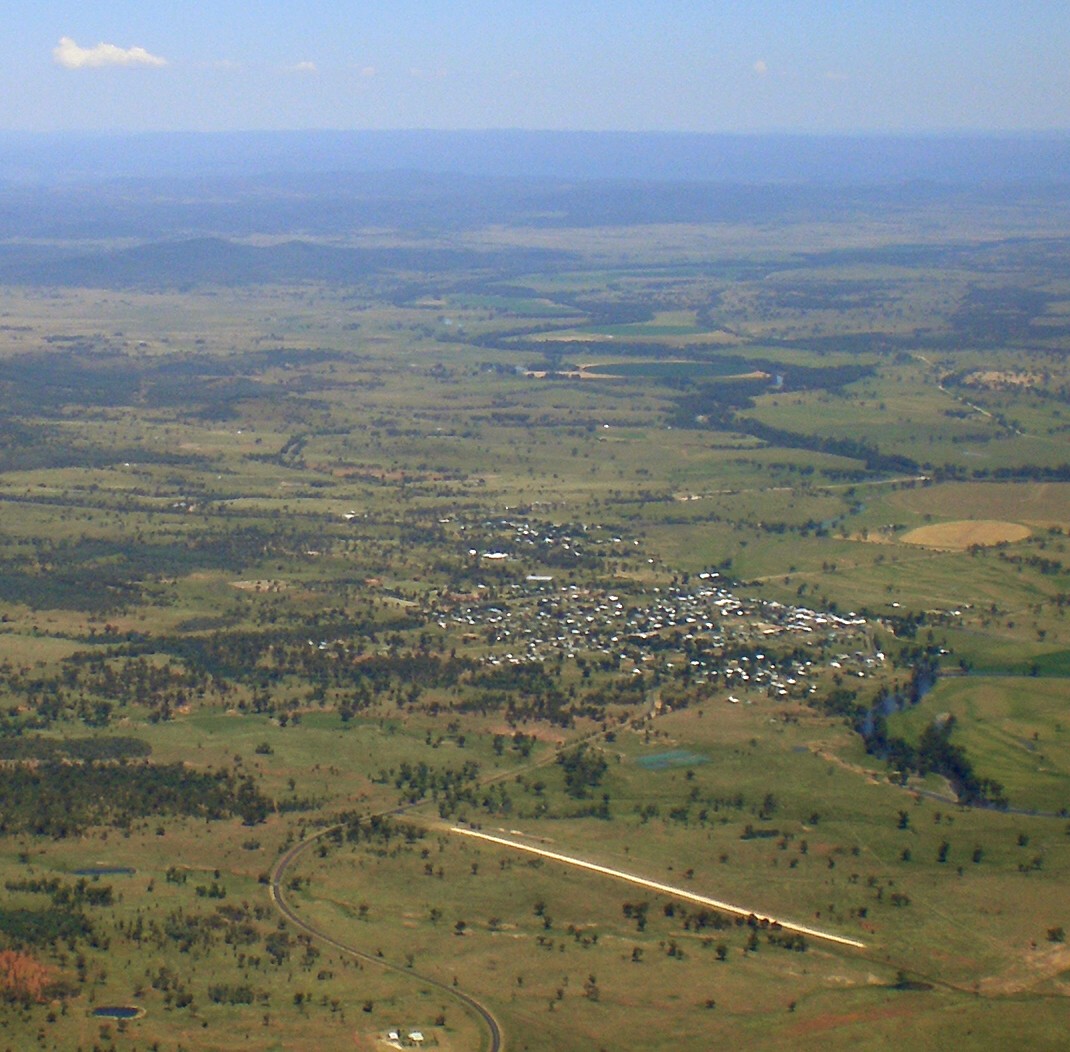The town of Texas is situated in Queensland, on the banks of the Dumaresq River, on the border with New South Wales, in the Darling Downs region, 230km south-west of Brisbane.
The Bigambul People
Texas is an area where various Aboriginal groups share interests in the land, including the Bigambul and Gambuwal/Kambuwal people.
In 1827, when explorer Allan Cunningham travelled north from the Hunter Valley in search of fertile land,
he crossed the Severn River and the Dumaresq River, between Texas and Boggabilla, and he saw smoke rising from Aboriginal camps.
By the 1840s, large numbers of Europeans began to move into the Darling Downs area to claim land, soon outnumbering the Aboriginal people and disturbing their access to food sources. Aboriginal people also had no immunity to diseases like influenza, whooping cough and measles, as these
diseases were passed to humans around 8,000 to 9,000 years ago, to human groups who had domesticated large herd animals.
With their survival under extreme threat, Aboriginal people began an intense guerilla war against the European settlers. However, by 1854, only 100 of the Bigambul people were left alive.
A letter exists from Goondiwindi, dated March 16 1874, requesting blankets for about 20 Aboriginal people at Texas.
Evidence of the long occupation of the Aboriginal people around Texas and the surrounding area can be found in the more than 1000 grinding grooves on rocks beside a creek near Inglewood QLD, where Bigambul people once sharpened their axes and spears.
Patrick Leslie (1815 –1881), a Scottish settler to Australia and his two brothers (Walter and George), were the
first to settle on the Darling Downs in 1840. In a letter that George Leslie wrote in 1841, there is evidence of the conflict between settlers and Aboriginal people in his words: "we never allow them to come about the station or hold any communication with them except it be with a gun or sword".
Also in 1840, the McDougall Brothers settled on a 32,000-hectare land grant originally called
Cullybullan, where Texas Station now exists. However, in the 1850s, the brothers left their lands and joined the mad rush to the goldfields, with thousands of others. Later when they returned home, the McDougall brothers found that they had been "jumped":
their land had been taken over by other settlers.
Much stress, effort and time passed before the McDougall’s could re-established their ownership of the disputed land, which led them to call their station "Texas" after the disputed state in the US. Or, so it is said.
 |
| Texas Station Homestead, Texas, QLD, Queensland Country Life (Qld. : 1900 - 1954), Thursday 10 December 1953 |
 |
| Suspension bridge at Texas Station connecting NSW and QLD, Week (Brisbane, Qld. : 1876 - 1934), Friday 9 June 1893 |
 |
| Charlie Weber's bullock team in Texas, year unknown. Photo courtesy SLQLD |
Farming
The area on which the Texas area sits, once comprised the Texas and Gunyan stations, which are now much smaller proprieties. The township, however, began as
a stop for teamster's on the NSW-Queensland border and to service the increasing sheep and cattle properties of the region.
In 1868, George Myles was appointed as Sheep Inspector and border customs officer at Texas.
The rich, alluvial river flats around the river encouraged farmers to plant crops, one of the earliest being corn. By the late 1860s, Chinese people were being employed to grow tobacco.
In 1875 the town was surveyed and businesses were cropping up on the banks of the Dumaresq River. More settlers were moving
to the region and the town was growing, with a newly constructed police barracks opened by Police Inspector Harris from Toowoomba. A J Thompson was the first police officer at Texas, sent there in 1890. Later he was an accountant and secretary of the general hospital and known as the "grand old man of Texas".
 |
| Mr A. J. Thompson, known as the "grand old man of Texas". Brisbane Courier (Qld. : 1864 - 1933), Saturday 9 February 1929 |
 |
| Opening of the Texas Hospital, Queensland, 1913, SLQLD |
 |
| Former Texas Police Station, built 1889, near the Durmaresq River. The building was moved after a flood to 44 Fleming Street, Texas, QLD. Became a Museum in 1972 |
The Town Moves
After this, the town was moved to higher ground, where
wide streets allowed the for the bullock train and the passage of stock.
Herbert Fraser Elwyn, was the pastoralist at
Gunyan Station from 1886 to 1926.
Arcot, the property of Charles Munroe JP, became successful stockbreeders.
 |
| Slab hut and other building on Arcot Station, near Pikdale, Queensland, June 1924. ' Back of the photo reads "Humpy on Arcot, Munroe's Station between S. Spur and Pikedale on road to Stanthorpe. Jim Ryan - mailman on steps. S. W. Queensland." |
 |
| This bridge, which was erected over 20 years ago, across the Dumaresq River, about a mile and a half from Texas 0n the Queensland-New South Wales border, is the only means of crossing the river in flood time. It is 6O feet long and 50 feet above water level and anchored to two trees, one on either side of thestream. Some time ago. one of the trees showed evidences of decay. |
School Days
Texas State School opened in 1887, attracting children from both the New SouthWales and Queensland side of the river.
 |
| Billy goat race at the Texas State School, Queensland, 1908, SLQLD |
Business and Pleasure
 |
| Members of the Texas State School Football Club, QLD, ca. 1905. Photo courtesy SLQLD. |
 |
| Hong Yuen general stores were run by the Fay family and their extended family. The first store began at Inverell in the 1890s as a small wooden shop. This advertisement is from an Italian/ Australian newspaper, Il Giornale Italiano (Sydney, NSW : 1932 - 1940), Wednesday 1 July 1936 |
 |
| Mr. and Mrs. M. D. M'DougalL picnic aces at Stanthorpe, Brisbane Courier (Qld. : 1864 - 1933), Wednesday 16 April 1930 |
 |
| Mrs. C. A. Munro (Arcot)- and Mrs. H. H. Jennings (Texas)«' Brisbane Courier (Qld. : 1864 - 1933), Wednesday 16 April 1930 |
Silver was discovered 12km east of Texas in 1890 and a mine was established in 1897. Lead and copper were also mined there.
 |
| Silver Spur, As seen from the north-west in 1916, QLD |
Tobacco
The rich alluvial river flats attracted crop growing, with corn being one of the earliest crops. In the 1880s, the Greenup bros. were growing tobacco called "Texas Gold Bar" and Stanley McMaster of
Runnymede, began using Chinese labourers, to grow tobacco, operating on the share-system. The Tobacco at this time was all sun or air-cured.
 |
| The type of camps used by Texas Bonds Limited, QLD, Smith's Weekly (Sydney, NSW : 1919 - 1950), Saturday 5 December 1931 |
By the turn of the century, 280 hectares were
under cultivation and a tobacco factory was erected at Texas. The output of tobacco declined in the 1920s, but increased dramatically in the 1930s, because of the rapid rise in import duty on tobacco leaf.
 |
| Old method of watering Tobacco, Weekly Times (Melbourne, Vic. : 1869 - 1954), Saturday 22 June 1929 |
 |
| Italian tobacco farmers, Weekly Times (Melbourne, Vic. : 1869 - 1954), Saturday 22 June 1929 |
 |
| Texas station Homestead is the centre of a rich cattle area, Queenslander (Brisbane, Qld. : 1866 - 1939), Thursday 28 February 1929 |
In 1908, Texas Station had 200 acres of tobacco leased to Chinese farmers. The station built the sheds and looked after the sales, while the share farmer paid one-third of the profit for the use of the land.
European growers, however, gradually took over from the Chinese and became an important part of the area's economy for many years, until the late 1960s.
For 30 years before 1960s, the Texas district was second in importance only to Mareeba-Dimbulah in tobacco production.
 |
| Interior of a tobacco factory -stemming the leaves, Texas. Sydney Mail (NSW : 1912 - 1938), Wednesday 2 April 1913 |
 |
| Drying tobacco, Texas, Southern Queensland. circa 1930, Queensland State Archives |
In 1969, the building of the Coolmunda Dam improved water supply and quality to the Texas district.
During the 60s, 70s and 80s, the tobacco industry operated under the government stabilisation scheme, which required a minimum of 50% Australian-grown leaf content in 1965. When this scheme was closed, Australian growers were unable to compete economically with leaf grown in countries, like China and South America. By the end of 1995, only 240 tobacco growers remained in Queensland.
Other Industries
Feral rabbit populations were observed in Tasmania in 1827. However, Thomas Austin, a Victorian grazier introduced wild rabbits to his property in Geelong, Victoria, for hunting in 1859. Rabbits quickly reproduced on mainland Australia, and soon, became a pest, invading southern Queensland in the early 1900s.
By the 1920s, rabbits were causing huge amounts of damage to crops, which prompted the development of a local industry. The Rabbit Processing Works, constructed in 1928, helped the Texas community to survive during the Great Depression, when 6,000 rabbits per day were processed at the works, with most being sent overseas. This industry helped sustain the town from the 1920s to the 1950s.
The Rabbit Processing Works building is the only known surviving rabbit and freezing works in Queensland, which is now
operating as a museum.




























































